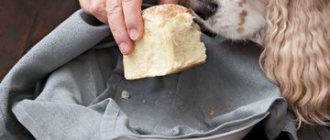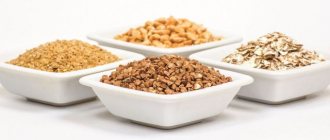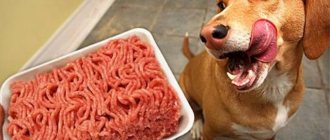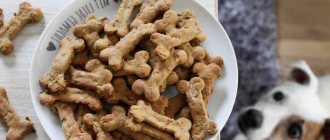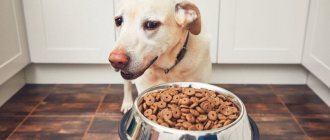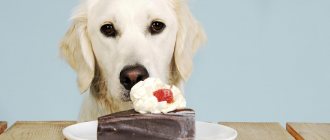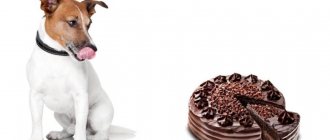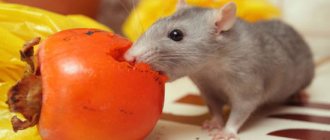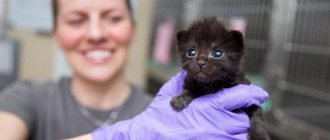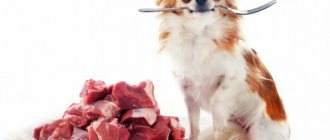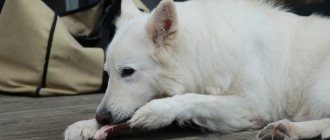A dog living in a house will inevitably try almost the entire diet of its owners. But not all products that are harmless or even beneficial for humans will be the same for animals. In this article we will figure out whether dogs can have cheese.
two opposing opinions on this matter :
- Veterinarians believe that cheese is dangerous for a dog’s health: it is too fatty and salty, and excessive consumption will harm the animal’s liver and pancreas.
- Trainers recommend using cheese as a reward for your pet: small pieces of the treat will do nothing.
Who is right? In fact, a product can be both beneficial and harmful . Let us stipulate that we are considering hard cheese.
Benefits and harms
Cheeses are rich in calcium, phosphorus and protein - substances that are beneficial for dogs. Indeed, even though dogs are carnivores, they cannot obtain all the substances necessary for life from meat alone . In addition, they also need a varied diet, just like humans.
Therefore, if a dog asks for cheese, this may indicate a lack of calcium and phosphorus in the body or their poor absorption.
Or about simple curiosity and the desire to try something new. ATTENTION: Calcium deficiency is a problem for many dogs, especially large ones.
Only a veterinarian can determine whether this applies to your pet, to whom you need to take the animal at the first symptoms - for example, if there is an interest in calcium-containing products. Another reason will be the usual love of dogs for cheese - they treat it almost the same way as people.
In addition to phosphorus, cheese also contains less useful substances: fats and salts (strictly prohibited for dogs), lactose (adult animals often develop lactose intolerance), cheeses from supermarkets are often processed and contain harmful chemicals.
It is difficult to find cheese that is completely harmless to dogs , and abuse of the product will lead to allergies, stomach upset and itchy skin. Therefore, you should accustom your pet to cheese gradually, from a small slice, and not in parallel with other unusual products or during a change of food.
This is the only way in case of troubles you will be able to determine exactly what caused them. If you don’t notice anything unusual in a couple of days, it means your pet can be rewarded with cheese periodically. If diarrhea or other discomfort occurs, stop giving the product.
Over time, you will be able to try a different type of cheese from a different manufacturer, or choose another, equally tasty, but harmless delicacy.
Why can't dogs have sweets?
No matter how close dogs are to humans, the physiology of four-legged animals is noticeably different from that of humans, therefore, nutrition is also different. This must be remembered whenever a pet tries to beg sweets from its owners in various ways: it looks pitifully into the eyes, climbs on hands, licks hands and face, and uses various other tricks. In this case, the owner usually thinks that nothing bad will happen just once, and hands his pet candy or cake. After a while, nothing really bad happens, and the dog gets a second helping of sweets and everything seems to be fine again. Then doubt arises: what if all the stories about the dangers of sweets are just fiction. To answer the question whether dogs can have sweets, you need to understand the subtleties of the metabolic processes of our furry friends. This issue needs to be looked into in depth.
Sugar for dogs
Sugar-containing products are an attractive treat for many animals and seem to attract them like a magnet. Most owners reward their pets with sweets, not noticing how they get used to such treats. Over time, the dog will ask for more and more treats. Imagine how much sugar a dog will receive during intense training, during which the owner can reward his pet up to 20 times or more. For example, 12 cubes of refined sugar is a large dose even for an adult man. This amount of sugar can lead to obesity.
In addition, the filtering systems in the animal's body will be overloaded, which will result in diabetes.
It is important to understand that sweets are not the only way to reward your dog. There are many alternatives that can be used to encourage your pet to follow training commands.
Why shouldn't dogs be given sweets?
In fact, everything is simply explained: carbohydrate metabolism in the body of predators is much slower than that of humans. One of the most harmful sugar-containing foods is chocolate. It contains a substance such as theobromine. It has a stimulating effect on the human nervous system. That is why chocolate can lift your spirits and relieve depression. Unlike the human body, the dog’s body is not able to get rid of the substance that is harmful to it - theobromine. As a result, it accumulates in the pet's body in large quantities, causing a toxic effect on the animal's organs and tissues.
The greatest harm is caused to the nervous system - the dog becomes aggressive or, conversely, lethargic. The next blow is taken by the heart. Just 100 grams of any chocolate can seriously undermine your pet's health. The harm is that almost all sweets, even the highest quality ones, contain xylitol. The substance is a polyhydric alcohol that acts as a sweetener. There is especially a lot of it in chewing gum, so it is necessary to wean your pet from picking up leftover food from the ground. One way or another, the chemicals that are present in incredible quantities in almost any confectionery product, namely various additives, flavors, dyes, preservatives, are harmful to animals.
Why does a dog ask for sweets?
If your dog is constantly begging for sweets, then you need to pay special attention to his daily menu. There is a possibility that this behavior is not at all connected with whims and taste preferences, but indicates problems with the health of the animal
The reasons may be the following:
- deficiency of essential vitamins and vital microelements;
- lack of carbohydrates (this can happen if the dog eats mainly meat);
- You taught your dog to eat sweets and suddenly stopped giving him treats.
Keep in mind that feeding sugary foods will not cure the problem. The pet needs to be given special food that contains naturally occurring sugars. This should be done in moderate doses, without abuse.
Varieties
When you decide to pamper your pet, take your time: not all cheeses are equally healthy .
- Hard cheese. It can definitely be given to your pet. It is rich in vitamins PP (4.5 mg per 100 grams), C (2.8 mg), B9 (19 mcg), A (400 mcg), contains phosphorus (540 mg), sodium (860 mg), potassium (100 mg), copper (70 mcg), magnesium (50 mg). It is valuable that hard cheeses do not contain lactose. Recommended varieties: Dutch, Adygei, Tilsit. Choose a simpler variety, with a reduced amount of salt and fat, and a natural composition.
- With mold. Such a treat, of course, will show how much you love your pet, but it is better to keep this expensive treat for yourself. Mold, even noble mold, contains many toxins that can negatively affect the animal.
- Fused. Undesirable: difficult to digest. Essentially, it simply spreads throughout the stomach and intestines. And during production, a lot of spices and salt are added to it, which are harmful.
- Smoked (sausage) cheese. It, like other smoked meats, is an absolute taboo for animals.
- Brine. As the name suggests, it contains too much salt, especially for a dog.
- Delicious. The main problem here is the fat content, which is more than 60% percent. In addition, the composition of such cheeses is complex; there are many unusual additives that can cause allergies and stomach upset.
- Cheese product. Everything is clear here: the dubious composition shows that neither a dog nor a person should eat it.
Let's talk separately about cottage cheese , which is sometimes also classified as cheese. This product is very useful for animals because it is rich in calcium. Healthy teeth and musculoskeletal system: this is what guarantees regular consumption of cottage cheese.
It is especially necessary for puppies, elderly individuals and pregnant bitches (it will prevent eclampsia - complications after childbirth associated with a lack of calcium in the body). Also, cottage cheese, like fermented milk, promotes digestion and prevents constipation.
IMPORTANT: Cottage cheese must be low-fat, otherwise the prevention of constipation will go into the radical phase - diarrhea.
It can be considered as a complete breakfast or dinner. At the same time, you should not give your animal old food (which has been in the refrigerator for more than three days) or thermally processed food (cheese cakes, lazy dumplings, cheesecakes).
Choose a type of cottage cheese that your pet will like and give it regularly - this will have a positive effect on health.
Tripe in the diet
Should you feed your animal the unappetizing component of a cow's stomach
, its owner must decide on his own. If you evaluate it by appearance, color and smell, this offal will always take last place in all kinds of ratings. It smells, to put it mildly, completely unattractively, its fuzzy part is unsightly, and its blackish tint often raises great fears and doubts - is it food? However, it is not always possible for a person to understand why his pet eats this or that product instantly, as is the case with tripe.
There are cases when owners not only pamper their pet, but literally feed this offal every day, and they practice this method of feeding starting from the age of two months. However, it is not always subjected to heat treatment. Such people do not realize that they are putting the health and even the life of their animal in great danger. And first of all, this is a helminthic infestation.
Benefit
So what is the secret of the popularity of this product?
? Many dog breeders claim that it contains all the microorganisms, vitamins and enzymes required for harmonious development and growth. They say that it is preferable to give the animal unpeeled, raw and untreated tripe. It seems like it’s enough to wash it well, cut it up and cut it into portions, and then feel free to give it to your pet.
Best articles: The hottest and coldest planets in the solar system
Harm
Breeders who feed their animals every day convince them that only this kind of food is the healthiest and most beneficial. However, there is also an opposite point of view.
Opponents of feeding dogs this offal justify their point of view in this way: fermentation processes take place in the proventriculus of the animal
. A huge variety of all kinds of microorganisms and bacteria take part in them.
And this offal does not contain many vitamins, but there are a large number of protozoa. Having feasted on a unique delicacy, the animal runs the risk of becoming infected with worms and ultimately suffering from a large number of serious diseases, the manifestations of which do not appear on the first day, but some time after the dangerous meal. Possible risks include giardiasis and isosporosis.
As you can see, the objectors have their own compelling arguments. But we will leave the decision whether or not to feed the pet tripe to its owner, who alone is responsible for the health of the ward.
How to give?
This product should be given as a treat, and not systematically, but unexpectedly, so that the animal perceives it not as a given, but as a reward . You can praise cheese for learned commands, for giving a paw, and take it with you on walks, training and performances. It should not be given to a sick dog. Also, don't feed him treats every day.
The cheese should be cut into small pieces, dried a little and then given to the dog. Do not throw them into your pet's mouth - he may choke. It's better to give by hand.
Let’s talk separately about the concept of “small piece”. Even 150-200 g is already a lot for a pet, the pieces must be really tiny, otherwise regular consumption of cheese will overload the liver and pancreas, push to the development of diseases or aggravate existing ones. You need to focus not on how much cheese you eat, but on the size of the animal.
The “animal-human” relationship is not understood correctly by everyone, so let’s give this example : a chihuahua receives 20 g of cheese - as much as we eat at a time with a sandwich.
But the average weight of a person is 60 kilos, and a Chihuahua reaches no more than 3 kilos. Using simple arithmetic, you can understand that this is equivalent to eating almost half a kilo (440 g) of hard cheese in one sitting.
also possible for a dog to taste cheese without asking your permission . If this piece was large, the animal will not be able to digest it and an upset stomach will occur. In this situation, you need to limit your pet's movement and wait for diarrhea.
The reasonable size of the piece does not cause cause for alarm: the mischievous dog will not feel any physical discomfort in this case.
When cheese is not allowed
For some individuals, the consumption of cheese is contraindicated, since the consequences can be unpredictable.
Here are the main categories of such dogs:
- with chronic gastrointestinal diseases;
- with liver and enzyme insufficiency;
- patients with chronic pancreatitis;
- having an allergic body;
- with lactose intolerance;
- weakened, recently undergone surgery;
- having problems with excess weight;
- those receiving dry food;
- puppies under 1 month of age.
There are no restrictions regarding breed. In the absence of contraindications, a dog of any breed can receive a small amount of cheese.
Do you give cheese to your pet? Monitor his condition closely for a month. If no unwanted reactions are observed, then his body tolerates the new product well. In this case, the treat can be made regular.
Who is prohibited?
You should not give cheese to dogs suffering from any liver problems : hepatitis, liver pathologies (acute pancreatitis), toxic liver degeneration, cirrhosis, ascites. This delicacy is also contraindicated if the dog is obese, has problems with the pancreas, or has low mobility.
If the pet is weakened, has recently undergone surgery or a trip, or has temporary digestive problems, then there is no need to give cheese just yet , like any other exotic treat.
Chihuahuas, Spitz and Yorkshire Terriers
Cheese can be given to any breed, there are no restrictions. The only thing is that for small breeds it will be difficult to calculate the correct dose.
also cause food allergies in dogs . Its symptoms:
- frequent bowel movements;
- irritation on the face, paws, ears, around the anus;
- constant scratching;
- in later stages – hair loss.
If you have an allergy, you should immediately stop giving cheese and never try to feed it to your dog again.
INTERESTING: Cheese is the second most likely allergen for dogs. In first place is beef, in third is chicken.
How often should you give cheese?
Dogs should not be fed it daily. It is recommended to give a few pieces occasionally, as a treat or reward. You can use small dried portions during training sessions as a reward for correctly executed commands. A dog can receive no more than 20-100 grams at a time, depending on the size of the animal.
Too much of a fatty product consumed daily by an animal can have a bad effect on the condition of the pancreas and liver. There is a high probability of developing an allergic reaction or exacerbation of existing chronic diseases.
You need to be very careful when including cheese in your pet’s diet. In order to assess the body's reaction to the product, it is recommended to administer it against the background of the usual diet.
Cheese is contraindicated for puppies under 1 month of age. You can start introducing small portions of treats when the puppy turns 1 year old. At this age, the gastrointestinal tract has already formed so much that it can absorb a small amount of it with a low fat content.
Possible reactions of the body to the appearance of cheese in the diet:
- frequent bowel movements;
- diarrhea;
- symptoms of intoxication;
- food allergies (skin itching, urticaria, irritation around the anus, hair loss, in severe cases - anaphylactic shock).
Is it possible for puppies?
Cheese should not be given during puppyhood. Until a month it will be a definite poison. It is best to start accustoming to treats from the age of one year, when the internal organs are fully formed and the animal can digest the treat. Cheese is also undesirable for pregnant and lactating bitches. But, if the expectant mother begins to be capricious, it is better to give her a tiny piece than to provoke stress by refusing.
IMPORTANT: starting from the second week after whelping, the dog’s blood calcium level may sharply decrease. So if she's interested in cheese at this time, it's worth checking with your veterinarian.
Why do dogs eat cat food?
The reasons why dogs choose to eat another pet's food may not even have to do with their digestion.
But in order to understand the problem and limit the animal from food that is harmful to it, it is important to understand the reasons why it does this.
Reasons why dogs love cat food
- Lack of food. It is the most commonplace, but far from rare reason. Due to the fact that the dog does not have enough food that its owner gives it, the pet begins to look for it in its neighbor's bowl. Moreover, unlike dogs, cats prefer to eat little but often, and therefore often leave a full plate of food unattended.
- The attractiveness of food in a cat's bowl, curiosity. Often this problem specifically affects puppies, because they are exploring the world and trying to try something new every day. That’s why they start tasting the cat’s food. The reason may also lie in strong flavorings, which are added to low-quality products to compensate for the lack of meat components and hide preservatives. The artificial aroma of meat will lure any pet.
- The desire to show leadership and superiority over the cat. Although most dogs are not desperate fighters for personal territory, some of them are characterized by a pronounced sense of freedom and personal leadership. This may depend on the breed of the dog, but is often determined by the individual character traits of each individual. In this case, dogs are driven only by the desire to show the cat who is boss in the house and to mark their superiority. And food habits and preferences have nothing to do with it.
Top Articles : Top 10 Cute Dog Breeds
How to stop a dog from eating cat food
An attentive and responsible owner, after identifying the cause and realizing the problem, will ask the question of how to wean the dog from feasting on someone else’s food. There are several solutions:
Monitor your dog's appetite. Perhaps increasing the portion will completely solve the problem
After all, it is important to remember that a puppy and an adult dog need different amounts of food to meet their vital needs. And with a sufficient portion, the pet will begin to gorge itself only on its own food and will stop even looking towards the other bowl. Give your cat food for only one meal
This method works especially well when there is always a person in the house who can add food to the animal at any moment upon request. In this case, you can put a very small portion to the cat (the serving size is determined only by the individual needs of each individual), which she will eat right away and leave the bowl empty. Food in bags, which is designed for one time, works well here. Strictly limit your dog's intake of cat food. This option should be resorted to only if the animal has developed a dependence on someone else's food. This happens especially often in the case of economy class feed. For the method to work faster, it is advisable to provide your pet with good physical activity. Then he will quickly get tired and hungry, and will no longer be so picky in his choice of food. And from this moment you can begin to accustom your dog to the right food. Place bowls of food in different rooms. This method is not the most effective and only works on a small number of pets. The main problem with the method is that one of the animals will need to be accustomed to a new feeding place. Place the cat's food plate out of reach of the dog. This option works well with dogs of small and toy breeds, which, unlike cats, cannot jump high and have access to much fewer places. Pour dog food into your cat's bowl. Using this method, you can solve the problem associated with the manifestation of unnecessary leadership qualities in a dog. In this case, the pet will only think that it is eating the food of its “rival”, but in fact it will begin to eat healthy and balanced food.
What to feed on natural food
If the dog is accustomed to receiving natural food, it is important to pay attention to the products that make up its diet, their combination and the presence of additional necessary elements. It is also very important how the owner processes the food - cooks, freezes or serves it raw.
Frequently changing your pet's diet, constantly switching the dog from one food to another, changing and mixing branded and natural products, is dangerous for the health of your four-legged friend!
If your pet feels well, it is better not to introduce innovations into his diet.
Best articles: Cretaceous period, or Cretaceous (145-66 million years ago)
If there are health problems, in addition to treatment with medications, it is often worth paying attention to nutrition. But only a doctor can prescribe therapy, including nutritional adjustments.
The basic rule of feeding natural food is the selection of suitable products, their proper preparation and selection of the optimal serving size. Feeding timing also plays an important role.
Adult dogs should be fed 1-3 times a day (preferably 2 times - morning and evening). Growing pets are fed according to their age:
- from 2 to 3 months – 5 – 6 times a day (every 3 – 4 hours);
- from 3 to 6 months – 4 – 5 times;
- from 6 to 12 months – 3 times;
- older than a year – 1 – 2 times.
The advantages of natural feeding are the high digestibility of nutrients contained in such food, as well as the variety of products and, accordingly, tastes. However, there are certain difficulties when feeding natural food: it is very difficult to find the optimal balance of all micro- and macroelements and nutrients. In addition, it takes a certain amount of time to prepare the food, and the prepared food does not last long. There is one more difficulty - it is necessary to add vitamin supplements to your pet’s food.
Beef is the best meat for a dog's diet.
Why do proponents of a raw food diet recommend it?
People who support the idea of feeding raw foods and avoiding conventional processed foods often cite the quality and composition of cooked foods. They claim that the content of meat and other important products that make up dog foods can be highly variable or of poor quality.
In addition, proponents of feeding dogs raw meat believe that both dry and canned food are very different from their natural diet in the wild, and that this type of diet is not as healthy for dogs as one that is more similar to their food in the wild. normal conditions in nature.
Raw food is usually produced by the dog owner himself, so he knows exactly what kind of food it is, where it comes from and what quality it is. Additionally, the diet can be tailored to meet the needs of a dog with specific allergies or other dietary restrictions. Raw foods do not require any of the preservatives or additives typically found in processed foods, and bones and fiber-rich plant foods can be beneficial in maintaining healthy teeth and gums.
In feed
Various by-products, including lung, are often added to animal feed. When choosing, you need to look at the composition. It is advisable that the packaging indicate which by-products and which animal were used for preparation.
It is also worth paying attention to the order of ingredients in the composition. By-products are useful, but it’s better if they don’t take first place
Dried treats
Particularly popular are dried offal products sold in pet stores, since owners do not need to spend time preparing them. When choosing this product, you must also look at the composition. It should contain the phrase “dried pieces of beef lung.” Apart from this, there should be nothing more.
Today the following companies are the most popular:
- Titbit;
- GreenQZin;
- "Farm delicacies";
- "Country delicacies";
- "Zoogourmand"
The main difference between all of the listed manufacturers from each other is the degree of dryness. It depends on the method used in production. If the composition does not contain any additional ingredients, then there is no need to worry about the quality. It's just a matter of your dog's taste and habits.
Character
Of course, each individual is unique, but there are some character traits that are common to all of them. Most often they are active, smart, attentive and can get what they want.
They are easy to train, but at the same time independent, which is why when training you need to first establish contact with them and set your own rules before the dog does. Families with small children should not have them, because they can accidentally squeeze them too hard or drop them, and these creatures are very fragile. They get along well with other pets, but hate rodents.
To read: Original nicknames for the German Shepherd: what to name a girl and a male dog?
Representatives of this breed are very emotional, passionate and capable of chasing any small rodent or bird encountered on a walk. They are courageous and cocky, but they are wary of strangers. They are characterized by tenderness and affection, they have common sense and some stubbornness, they are cheerful and good-natured. However, despite all his kindness, if you offend a Yorkie, he is ready to bite, so the best solution is to treat them calmly and affectionately. Try to protect him from stress, otherwise he will become nervous and start mischievous; besides, stress is bad for your health.
Meat selection
- beef (lean);
- turkey,
- horsemeat,
- rabbit meat;
- chicken,
- mutton.
The specific option must be selected taking into account the individual characteristics of the animal.
Among the offal
, which can also be used to support canine health, include the following:
- kidneys;
- beef tripe;
- udder;
- heart.
The basis of your pet's diet should be beef, preferably lean. Meat for dogs does not have to be first grade. According to experts, it is undesirable to feed an animal with selected cuts and high-quality meat. It is also necessary to exclude chicken legs and fatty pork from the diet. By-products for a pet are required along with meat. For certain breeds of dogs, they can replace meat in their value.
The animal will eat unprocessed offal without harm to health and with pleasure
It is important to note that this food is not as nutritious as meat, with the exception of the udder. The lungs and liver are on a separate list
They are allowed to be added to the diet, but not very often, since the dog’s intestines have a hard time digesting raw liver. But if there is no noticeable reaction, you can give it a little at a time.
Uncleaned, unprocessed beef tripe is a special dish for four-legged friends. We will talk about it in detail below.
One of the most common questions among dog breeders is what kind of meat is best to feed your pet: boiled or raw.
The vast majority of veterinarians, specialists, dog breeders and adherents of natural nutrition agree that uncooked meat for domestic dogs is the healthiest
. It is recommended not to pour boiling water over turkey, chicken, beef or other meat, but rather to freeze it thoroughly beforehand. Some people believe that there is no need to freeze meat.
It doesn't happen very often that a dog gets sick because the meat has not been cooked. This is due to the fact that the content of hydrochloric acid in the stomach of an animal is much higher than that of a person, and this component perfectly disinfects food.
The following rule must be observed: do not buy untested meat from the public market. Meat from unhealthy animals may be sold there. In this case, even freezing will not destroy harmful organisms. It is safer to purchase products for your beloved pet at specialized retail outlets, where they can provide quality certificates and relevant sanitary documents. In this case, it will be possible to feed your four-legged friend meat without preliminary heat treatment, without reducing its nutritional value.
Proponents of the second theory point out
because domestic animals are too pampered to eat raw meat, so it should be boiled. It is also necessary to boil meat for the reason that the natural menu is dangerous due to poisoning, as well as increased aggression and problems in raising the dog.
Which of these opinions to adhere to is a personal matter for everyone, but in both the first and second cases it is advisable to choose proven, high-quality meat.
